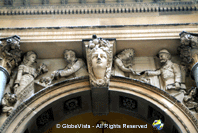Sydney General Post Office sculptures

Public Art: Sydney General Post Office sculptures
Design: ©Tomaso Sani (1839-1915)
Sculptors: © Giovanni Fontana (1821-1893) and Tomaso Sani
Description: The three central figures in Martin Place, including Queen Victoria were created in Italy by Italian sculptor, Signor Giovanni Fontana, from the designs of Australian/Italian sculptor, Tomaso Sani. They were carved from Sicilian Marble.
Around the arches of the building are carvings of symbolic figures representing the Arts, Science, Agriculture and Commerce.
On the keystones are heads representing Neptune, Jupiter, Saturn, Mercury and Minerva.
Also around the building are carvings of Queen Victoria, the Prince of Wales and the Duke of Edinburgh.
If you look long and hard enough you can find carvings of well-known explorers such as Captain Cook, La Perouse, Tasman, Columbus, and Vasco da Gamma.
Also included in the carvings are four of New South Wales governors, Sir John Young, the Earl of Belmore, Sir Hercules Robinson and Lord Loftus.
The George Street and Martin Place facade carvings were free of controversy in fact they were highly regarded. It was those Pitt Street bassorievo’s (bas-reliefs) which attracted all the attention and criticism.
Date Unveiled: 1874
Location: The Sydney GPO is located at 1 Martin Place, Sydney, Australia.
Controversy: In 1882 Barnet had requested a costing from McCredie Brothers for a series of carvings to be placed in the spandrels of the arches. The carvings were to represent professions and trades from everyday life. Barnet believed the Post Office being a public utility, should have carvings representing the life of everyday workers, professionals and tradesmen.
The commission of creating the carvings went to Italian sculptor Tomaso Sani. Unfortunately, following the viewing of the carvings, the general consensus of the day was that they were considered crass and caricature-like and something that should never be displayed on such a building of grandeur. In other words they were modestly realistic representations depicted in a style ordinary people could understand and therefore not worthy.
This case of architectural snobbery caused bitter debate amongst politicians and the establishment who used the press to attack Barnet. It wasn’t long before there was a move in the Legislative council to remove the carvings. The Chief Justice commented that Barnet should have “consulted gentlemen of taste and judgment in art”. They even went so far as to set up a board to decide on the carving’s fate.
As you would expect the report came back condemning the carvings and recommending their immediate removal. Barnet, not one to be bullied by authority sent a letter of rebuttal. It seemed the issue had come to a stalemate.
In 1884 a further attempt to have the carvings removed was made when the issue was referred to the President of the Royal Academy in London. It would take another three years before the Legislative Assembly finally voted for the carvings to remain.
Ironically, today thousands of people walk past the building hardly even giving them a second glance.
Garibaldi Rumour: A few years ago a rumour spread that one of the carvings on the GPO was that of Italian revolutionary hero, Giuseppe Garibaldi. As it was common (as it still is today) for artists to leave their “mark” on their work, all focus turned to sculptor Tomaso Sani, who was known for his sense of humour. After a little digging it was discovered that Sani was working in Florence at the same time as Garibaldi was experiencing widespread popularity in Italy. This was at a time when Italy was heading for the Unification of the Italian States.
So was Garibaldi ever found? Rumours persisted and eventually, a tiny image on the side of the “Italy” head was identified as an image of interest! Some believe it is in fact Garibaldi yet others believe it is an image of Barnet kneeling to write his name on the building. You be the judge!
GPO Background: The Sydney GPO is one of Colonial Architect James Barnet’s finest creations and is a great example of Victorian Free Classical style. Barnet was inspired by the Palazzi Communali, the splendid public buildings of Renaissance Italy. Read More… Sydney General Post Office
Faces of the GPO: As you walk through Martin Place you may notice the faces staring down at you from the General Post Office building. There are twenty-four faces, on either side of the central carving of Queen Victoria, each representing a continent, country or state. In order from left to right are Europe, Asia, Russia, Italy, Germany, United States of America, Cananda, India, France, Belgium, Austria, Polynesia, Australia, New Zealand, Tasmania, Queensland, Ireland, England, Scotland, Victoria, South Australia, Western Australia, Africa and South America.

This is great thank you.
Who is the author? I would like to cite this in a report I am writing
Fascinating story, I wonder whether in today’s world these sculptures would create similar controversy, if interpreted from today’ s point of view? Probably would, human nature with time changes its attire but not its habits.